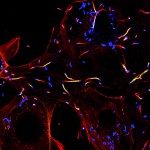Link to Pubmed [PMID] – 20154205
J. Immunol. 2010 Mar;184(6):2966-73
Human myeloid cells express both activating and inhibitory receptors of the FcgammaRII family. FcgammaRIIA mediates processes associated with cell activation, including phagocytosis of IgG-opsonized particles, whereas coengagement of the inhibitory FcgammaRIIB downregulates such signaling. We analyzed the relative recruitment of these two receptors during phagocytosis of IgG-coated particles by ts20 Chinese hamster fibroblast cells cotransfected with both receptors carrying distinguishable fluorescent protein tags. We found that FcgammaRIIA is substantially enriched at sites of particle binding relative to its inhibitory counterpart, with a greater than 2-fold increase in the local ratio of activating to inhibitory receptor compared with that for the plasma membrane as a whole. Experiments with chimeric receptors revealed that the preferential enrichment of FcgammaRIIA results from differences between the extracellular domains of the receptors, and indicated that the lesser recruitment of FcgammaRIIB limits its ability to effectively inhibit FcgammaRIIA-mediated phagocytosis. Mutagenesis studies indicated that FcgammaRIIA residues leucine 132 and phenylalanine 160, which lie in IgG-binding regions of FcgammaRIIA and which differ in FcgammaRIIB, both contribute to the local relative enrichment of FcgammaRIIA by increasing its affinity for IgG1 relative to that of FcgammaRIIB. In human monocytes, engagement of approximately equal amounts of FcgammaRIIB was required to substantially inhibit FcgammaRIIA-mediated phagocytosis. These results demonstrate that differences in affinity for IgG between activating and inhibitory FcgammaR can result in substantial local changes in their relative concentrations during phagocytosis, with important functional consequences.
